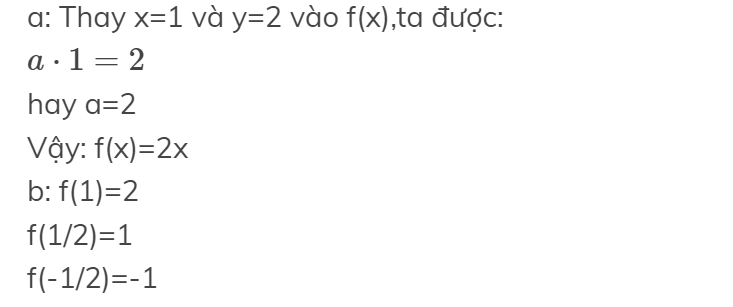Hãy nhập câu hỏi của bạn vào đây, nếu là tài khoản VIP, bạn sẽ được ưu tiên trả lời.

Ta có: \(f\left(0\right)=a.0^2+b.0+c=0+0+c=c\) mà \(f\left(0\right)=1\)\(\Rightarrow c=1\)
\(f\left(1\right)=a.1^2+b.1^2+c=a+b+1\)mà \(f\left(1\right)=2\)\(\Rightarrow a+b+1=2\)\(\Rightarrow a+b=1\)
\(f\left(2\right)=a.2^2+2.b+c=4a+2b+1\)mà \(f\left(2\right)=8\)\(\Rightarrow4a+2b+1=8\)\(\Rightarrow4a+2b=7\)\(\Rightarrow2\left(2a+b\right)=7\)\(\Rightarrow2a+b=3,5\)\(\Rightarrow a+\left(a+b\right)=3,5\)\(\Rightarrow a+1=3,5\)\(\Rightarrow a=2,5\)
Lại có: \(a+b=1\)\(\Rightarrow2,5+b=1\)\(\Rightarrow b=1-2,5=-1,5\)
Ta có: \(f\left(-2\right)=a.\left(-2\right)^2+b.\left(-2\right)+c=2,5.4+\left(-1.5\right).\left(-2\right)+1=10+3+1=14\)

\(\text{1)}\)
\(\text{Thay }x=-2,\text{ ta có: }f\left(-2\right)-5f\left(-2\right)=\left(-2\right)^2\Rightarrow f\left(-2\right)=-1\)
\(\Rightarrow f\left(x\right)=x^2+5f\left(-2\right)=x^2-5\)
\(f\left(3\right)=3^2-5\)
\(\text{2)}\)
\(\text{Thay }x=1,\text{ ta có: }f\left(1\right)+f\left(1\right)+f\left(1\right)=6\Rightarrow f\left(1\right)=2\)
\(\text{Thay }x=-1,\text{ ta có: }f\left(-1\right)+f\left(-1\right)+2=6\Rightarrow f\left(-1\right)=2\)
\(\text{3)}\)
\(\text{Thay }x=2,\text{ ta có: }f\left(2\right)+3f\left(\frac{1}{2}\right)=2^2\text{ (1)}\)
\(\text{Thay }x=\frac{1}{2},\text{ ta có: }f\left(\frac{1}{2}\right)+3f\left(2\right)=\left(\frac{1}{2}\right)^2\text{ (2)}\)
\(\text{(1) - 3}\times\text{(2) }\Rightarrow f\left(2\right)+3f\left(\frac{1}{2}\right)-3f\left(\frac{1}{2}\right)-9f\left(2\right)=4-\frac{1}{4}\)
\(\Rightarrow-8f\left(2\right)=\frac{15}{4}\Rightarrow f\left(2\right)=-\frac{15}{32}\)

a) Thay f(0);f(\(-\frac{1}{2}\)) vào f(x)=2-x2 ta được:
\(f\left(0\right)=2-0^2=2\)
\(f\left(-\frac{1}{2}\right)=2-\left(-\frac{1}{2}\right)^2=\frac{7}{4}\)
b) y = f(x) = 2-x2
Ta có f(x-1) = 2- (x-1)2
f(1-x) = 2 - (1-x)2 = 2 - (x-1)2
nên f(x-1) = f(1-x)

Ta có: y=f(x)=x2−2y=f(x)=x2−2
Thay f(2); f(1); f(0); f(-1); f(-2) vào hàm số:
f(2)=22−2=4−2=2f(2)=22−2=4−2=2
f(1)=12−2=1−2=−1f(1)=12−2=1−2=−1
f(0)=02−2=−2f(0)=02−2=−2
f(−1)=(−1)2−2=1−2=−1f(−1)=(−1)2−2=1−2=−1
f(−2)=(−2)2−2=4−2=2

\(f\left(2\right)=2^2-2=2\)
\(f\left(1\right)=1^2-2=-1\)
\(f\left(0\right)=0^2-2=-2\)
\(f\left(-1\right)=\left(-1\right)^2-2=-1\)
\(f\left(7\right)=7^2-2=47\)
Ta có : y=f(x) =x\(^2\) - 2
- f(2) = 2\(^2\) – 2 = 4 – 2 = 2
- f(1) = 1\(^2\) – 2 = 1 – 2 = – 1
- f(0) = 0\(^2\) – 2 = 0 – 2= – 2
- f(-1) = (-1)\(^2\) – 2 = 1 – 2= – 1
- f(7) = (7)\(^2\) – 2 = 49 – 2 = 47

a)f(−1)=−1−2=−3f(0)=0−2=−2f(−1)=−1−2=−3f(0)=0−2=−2
b) Ta có phương trình:
x−2=0⇔x=2

Vì \(2^2=\left(-2\right)^2\) nên \(2^2-2=\left(-2\right)^2-2\)
hay F(2)=F(-2)
Thay x=2 vào hàm số \(y=f\left(x\right)=x^2-2\), ta được:
\(F\left(2\right)=2^2-2=4-2=2\)
Vậy: F(-2)=2; F(2)=2
Thay x=0 vào hàm số \(y=f\left(x\right)=x^2-2\), ta được:
\(F\left(0\right)=0^2-2=-2\)
Vậy: F(0)=-2
Thay x=1 vào hàm số \(y=f\left(x\right)=x^2-2\), ta được:
\(F\left(1\right)=1^2-2=1-2=-1\)
Vậy: F(1)=-1
y = f(x) = x2 - 2
f(2) = 22 - 2 = 4 - 2 = 2
f(1) = 12 - 2 = 1 - 2 = -1
f(0) = 02 - 2 = 0 - 2 = -2
f(-1) = (-1)2 - 2 = 1 - 2 = -1
f(-2) = (-2)2 - 2 = 4 - 2 = 2